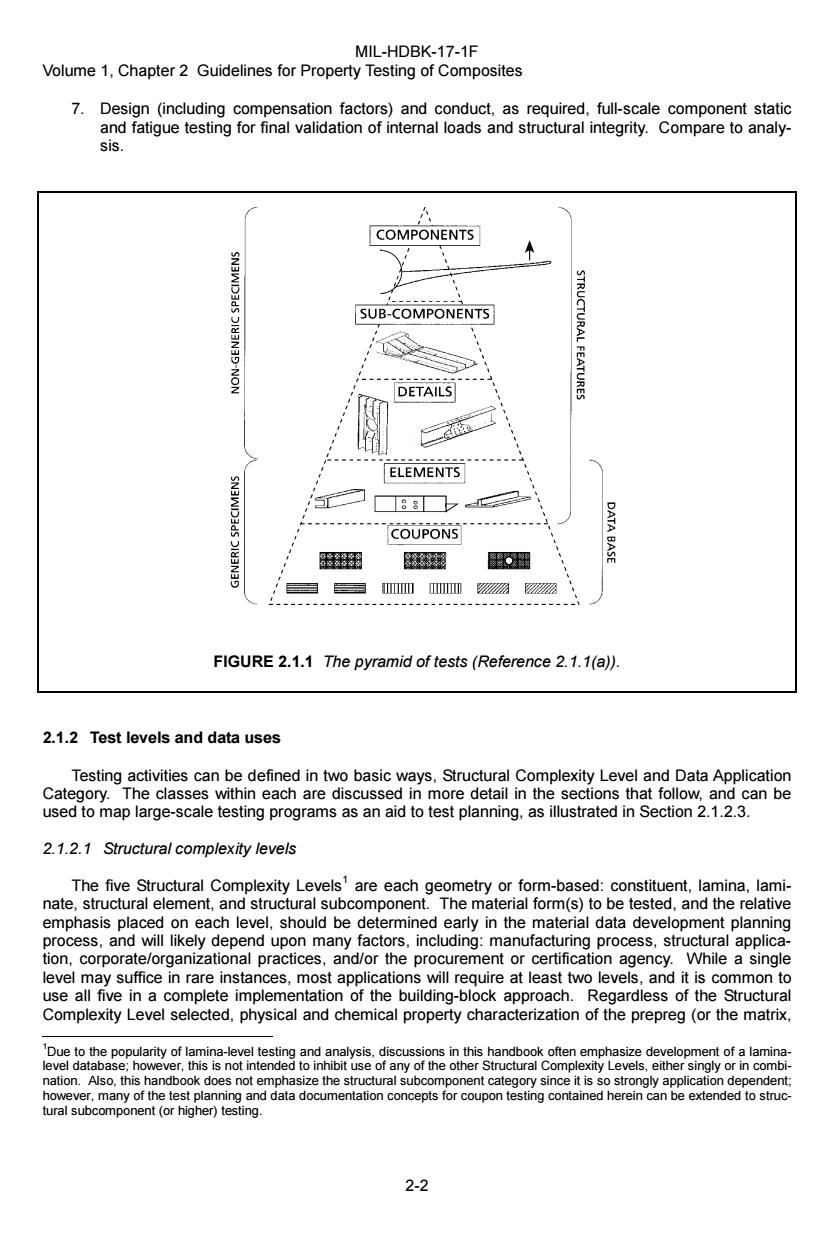正在加载图片...

MIL-HDBK-17-1F Volume 1,Chapter 2 Guidelines for Property Testing of Composites 7.Design (including compensation factors)and conduct,as required,full-scale component static and fatigue testing for final validation of internal loads and structural integrity.Compare to analy- SiS. COMPONENTS SUB-COMPONENTS STRUCTURAL FEATURES DETAILS ELEMENTS 88☐ COUPONS 卧理 DATA BASE 0 ⅢⅢ22☒ FIGURE 2.1.1 The pyramid of tests(Reference 2.1.1(a)). 2.1.2 Test levels and data uses Testing activities can be defined in two basic ways,Structural Complexity Level and Data Application Category.The classes within each are discussed in more detail in the sections that follow,and can be used to map large-scale testing programs as an aid to test planning,as illustrated in Section 2.1.2.3. 2.1.2.1 Structural complexity levels The five Structural Complexity Levels'are each geometry or form-based:constituent,lamina,lami- nate,structural element,and structural subcomponent.The material form(s)to be tested,and the relative emphasis placed on each level,should be determined early in the material data development planning process,and will likely depend upon many factors,including:manufacturing process,structural applica- tion,corporate/organizational practices,and/or the procurement or certification agency.While a single level may suffice in rare instances,most applications will require at least two levels,and it is common to use all five in a complete implementation of the building-block approach.Regardless of the Structural Complexity Level selected,physical and chemical property characterization of the prepreg(or the matrix, Due to the popularity of lamina-level testing and analysis,discussions in this handbook often emphasize development of a lamina- level database;however,this is not intended to inhibit use of any of the other Structural Complexity Levels,either singly or in combi- nation.Also,this handbook does not emphasize the structural subcomponent category since it is so strongly application dependent: however,many of the test planning and data documentation concepts for coupon testing contained herein can be extended to struc- tural subcomponent(or higher)testing. 2-2MIL-HDBK-17-1F Volume 1, Chapter 2 Guidelines for Property Testing of Composites 2-2 7. Design (including compensation factors) and conduct, as required, full-scale component static and fatigue testing for final validation of internal loads and structural integrity. Compare to analysis. FIGURE 2.1.1 The pyramid of tests (Reference 2.1.1(a)). 2.1.2 Test levels and data uses Testing activities can be defined in two basic ways, Structural Complexity Level and Data Application Category. The classes within each are discussed in more detail in the sections that follow, and can be used to map large-scale testing programs as an aid to test planning, as illustrated in Section 2.1.2.3. 2.1.2.1 Structural complexity levels The five Structural Complexity Levels1 are each geometry or form-based: constituent, lamina, laminate, structural element, and structural subcomponent. The material form(s) to be tested, and the relative emphasis placed on each level, should be determined early in the material data development planning process, and will likely depend upon many factors, including: manufacturing process, structural application, corporate/organizational practices, and/or the procurement or certification agency. While a single level may suffice in rare instances, most applications will require at least two levels, and it is common to use all five in a complete implementation of the building-block approach. Regardless of the Structural Complexity Level selected, physical and chemical property characterization of the prepreg (or the matrix, 1 Due to the popularity of lamina-level testing and analysis, discussions in this handbook often emphasize development of a laminalevel database; however, this is not intended to inhibit use of any of the other Structural Complexity Levels, either singly or in combination. Also, this handbook does not emphasize the structural subcomponent category since it is so strongly application dependent; however, many of the test planning and data documentation concepts for coupon testing contained herein can be extended to structural subcomponent (or higher) testing